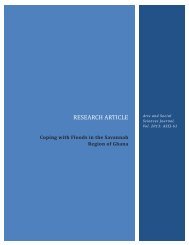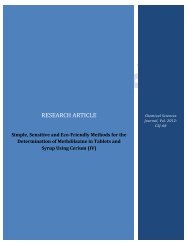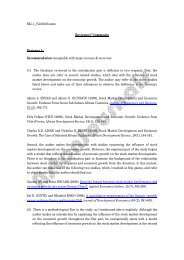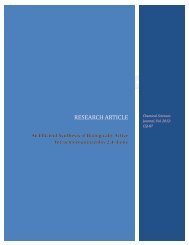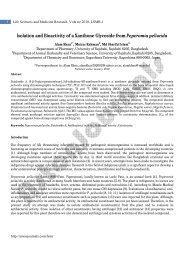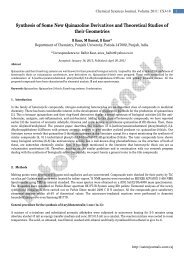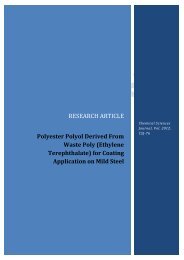Reproductive Biology of the Indian Oil Sardine Sardinella longiceps ...
Reproductive Biology of the Indian Oil Sardine Sardinella longiceps ...
Reproductive Biology of the Indian Oil Sardine Sardinella longiceps ...
Create successful ePaper yourself
Turn your PDF publications into a flip-book with our unique Google optimized e-Paper software.
RESEARCH ARTICLE<br />
Fisheries and<br />
Aquaculture Journal,<br />
Vol. 2012: FAJ-44<br />
<strong>Reproductive</strong> <strong>Biology</strong> <strong>of</strong> <strong>the</strong> <strong>Indian</strong> <strong>Oil</strong> <strong>Sardine</strong> <strong>Sardine</strong>lla<br />
<strong>longiceps</strong> From Al-Seeb Waters <strong>of</strong>f Oman
Fisheries and Aquaculture Journal, Vol. 2012: FAJ-44<br />
1<br />
<strong>Reproductive</strong> <strong>Biology</strong> <strong>of</strong> <strong>the</strong> <strong>Indian</strong> <strong>Oil</strong> <strong>Sardine</strong> <strong>Sardine</strong>lla <strong>longiceps</strong><br />
From Al-Seeb Waters <strong>of</strong>f Oman<br />
SM Al-Jufaili<br />
Department <strong>of</strong> Marine Science and Fisheries, College <strong>of</strong> Agricultural and Marine Sciences,<br />
Sultan Qaboos University, Al-Khod 123, Muscat, Sultanate <strong>of</strong> Oman.<br />
Correspondence: Saud M Al-Jufaili, sjufaily@squ.edu.om, sjufaily88@gmail.com<br />
Accepted: July 19, 2012; Published: August 5, 2012<br />
Abstract<br />
The objective <strong>of</strong> this study is to examine <strong>the</strong> reproductive biology <strong>of</strong> <strong>the</strong> Omani-<strong>Indian</strong> oil sardine <strong>Sardine</strong>lla <strong>longiceps</strong> from Al-<br />
Seeb area <strong>of</strong>f <strong>the</strong> Omani waters. During <strong>the</strong> period January 2004–December 2008, a total <strong>of</strong> 1592 sardines were sampled. The<br />
lengths <strong>of</strong> <strong>the</strong> sampled fish ranged from 11.9 to 22 cm with a mean length <strong>of</strong> 16.5 ± 1.84 cm and modal length <strong>of</strong> 15.5 cm. Their<br />
weights ranged from 14 to 94.6 g with a mean weight <strong>of</strong> 42.43 ±15.19 g and modal weight <strong>of</strong> 43.7 g. The length–weight<br />
2.99<br />
relationship equations analyzed for <strong>the</strong> combined sex, female, and male sardines wereW<br />
0.009<br />
L ,<br />
W 0.011<br />
L<br />
2.94<br />
, and<br />
W 0.001<br />
L<br />
2.94<br />
, respectively. The length at 50% maturity for combined sex, female, and male<br />
sardines was 16.35, 16.46, and 16.28 cm, respectively. During <strong>the</strong> study, <strong>the</strong> Omani sardines were observed to spawn in<br />
October, June, and July, September, June, and January and September during <strong>the</strong> years 2004, 2005, 2006, 2007, and 2008,<br />
respectively. During <strong>the</strong> sampling period, <strong>the</strong> relative condition factor K n varied from one year to ano<strong>the</strong>r and ranged from 0.36<br />
to 1.46 with a mean <strong>of</strong> 0.9 ± 0.08. An overall mean sex ratio <strong>of</strong> 0.68 ± 0.02 proved to be significantly different from <strong>the</strong><br />
expected <strong>the</strong>oretical sex ratio <strong>of</strong> 0.5 ( 2 = 200; df = 1; P 0.05).<br />
Keywords: Oman; <strong>Indian</strong> oil <strong>Sardine</strong>; biology.<br />
1. Introduction<br />
The <strong>Indian</strong> oil sardine <strong>Sardine</strong>lla <strong>longiceps</strong> is considered to be an important small pelagic fish for <strong>the</strong> traditional<br />
Omani fishermen along <strong>the</strong> Omani coast (Figure 1). <strong>Sardine</strong>s along <strong>the</strong> Omani coast are harvested mainly by beach<br />
seines, gill nets, and occasionally by cast nets. The sardine landings for <strong>the</strong> period 2002–2009 were reported to be<br />
stable and never significantly changed from <strong>the</strong> average <strong>of</strong> 34,673 mt (Figure 2). The small pelagic coastal<br />
traditional fishery in Oman includes sardines, <strong>Indian</strong> mackerel, anchovies, small jacks, mullets, needle fish, and<br />
“o<strong>the</strong>r small pelagics” (a mixture <strong>of</strong> different small pelagics). During <strong>the</strong> period 1994–2007, sardines contributed to<br />
76% <strong>of</strong> <strong>the</strong> total small pelagic landings and 51% to <strong>the</strong> total values [1].<br />
Figure 1: Map <strong>of</strong> Oman showing <strong>the</strong> regions.<br />
http://astonjournals.com/faj
Landings (mt)<br />
2 Research Article<br />
70000<br />
60000<br />
50000<br />
40000<br />
30000<br />
20000<br />
10000<br />
0<br />
2000 2001 2002 2003 2004 2005 2006 2007 2008 2009<br />
Years<br />
Figure 2: Total landings <strong>of</strong> Omani-<strong>Indian</strong> oil sardine during 2000–2009.<br />
Beach seines and purse seines are modified gill nets that require up to 12 people to set and haul.<br />
Fishermen can catch about 30–40 tons <strong>of</strong> sardines in a day when <strong>the</strong>y are abundant. In general, beach seines are<br />
<strong>the</strong> most common type <strong>of</strong> gears used for catching sardines [2]. The Omani S. <strong>longiceps</strong> is a batch-fecund multiple<br />
spawner and <strong>the</strong> available studies on <strong>the</strong> gonadosomatic index (GSI) <strong>of</strong> <strong>the</strong> fish indicate that sardines in Oman<br />
spawn during March, August, and February [1], and April and October [3–5]. The length at 50% maturity ranged<br />
between 150 and 174 mm total length for <strong>the</strong> combined sex, female, and male sardines [5].<br />
The aim <strong>of</strong> this paper is to fur<strong>the</strong>r study <strong>the</strong> reproduction <strong>of</strong> S. <strong>longiceps</strong> in Oman. The analysis included<br />
determination <strong>of</strong> spawning season, length–weight relationship, sex ratio, length at 50% maturity, and relative<br />
condition factor <strong>of</strong> <strong>the</strong> fish. The results <strong>of</strong> this study will help in building up and compiling information and<br />
database needed for stock assessment, management, and development <strong>of</strong> <strong>the</strong> Omani sardine’s stock parameters.<br />
2. Methods<br />
<strong>Sardine</strong>s were collected regularly and randomly from Al-Seeb landing site, which is considered to be one <strong>of</strong> <strong>the</strong><br />
active fish markets along <strong>the</strong> Omani coast line. A total <strong>of</strong> 1592 sardines were collected during <strong>the</strong> sampling period<br />
January 2004–December 2008. For fur<strong>the</strong>r analysis, fish samples were put in cool box with ice flakes and<br />
transported to <strong>the</strong> Department <strong>of</strong> Marine Science and Fisheries laboratory at <strong>the</strong> Sultan Qaboos University, which<br />
is 20 min away from <strong>the</strong> landing site. The cool box temperature was maintained at 20–23C. Thereupon, <strong>the</strong><br />
sardines were at once analyzed for total length to nearest 0.1 cm accuracy measuring from <strong>the</strong> tip <strong>of</strong> <strong>the</strong> mouth to<br />
<strong>the</strong> longest lobe <strong>of</strong> <strong>the</strong> caudal fin. Weight <strong>of</strong> <strong>the</strong> fish and gonads were also recorded to <strong>the</strong> nearest 0.01 g using an<br />
electronic balance (Mettler PE 360). Fur<strong>the</strong>rmore, <strong>the</strong> samples were analyzed for sex and maturity stages visually.<br />
Five maturity stages were allocated based on shape, color, and appearance <strong>of</strong> gonads [6]. For each sex, <strong>the</strong><br />
maturity stages were grouped into immature (stages I and II), maturing (stage III), mature (stages IV and V), and<br />
spent.<br />
The length–weight relationship was determined for <strong>the</strong> male (n = 487), female (n = 1022), and combined<br />
sex samples (n = 1592) by <strong>the</strong> exponential equation W = aTL b [7], where W is <strong>the</strong> weight <strong>of</strong> <strong>the</strong> fish in grams, TL<br />
<strong>the</strong> total length <strong>of</strong> <strong>the</strong> fish in cm, and variables “a” and “b” <strong>the</strong> regression coefficients. The relative condition factor<br />
( ) <strong>of</strong> <strong>the</strong> fish was determined by <strong>the</strong> equation [8]. Sex ratios were expressed as <strong>the</strong> total<br />
number <strong>of</strong> females to <strong>the</strong> sum <strong>of</strong> total number <strong>of</strong> males and females. The 2 -test was used to test whe<strong>the</strong>r <strong>the</strong> sex<br />
ratio was different from <strong>the</strong> expected and <strong>the</strong>oretical sex ratio <strong>of</strong> 0.5. The GSI was estimated as (gonad<br />
weighttotal fish weight) 100 [9]. The length at 50% maturity for <strong>the</strong> male (n = 464), female (n = 846), and<br />
combined sex sardines (n = 1367) was estimated by applying <strong>the</strong> cumulative frequency (f, %).<br />
3. Results<br />
3.1. Population structure<br />
A total <strong>of</strong> 1592 sardines were sampled during <strong>the</strong> study period. The total length <strong>of</strong> <strong>the</strong> sardines ranged from<br />
11.9 to 22.0 cm with a mean length <strong>of</strong> 16.5 ± 1.84 cm and modal length <strong>of</strong> 15.5 cm. The smallest sardine (unsexed)<br />
was sampled from <strong>the</strong> October 2008 samples and <strong>the</strong> largest (female) was sampled in January 2004 and April<br />
http://astonjournals.com/faj
Fisheries and Aquaculture Journal, Vol. 2012: FAJ-44<br />
3<br />
2007. A total <strong>of</strong> 1022 (68%) female and 487 (32%) male sardines were sampled during this study (Figure 3). The<br />
minimum number <strong>of</strong> sardines were sampled in 2006 (females = 135 and males = 66) and all <strong>the</strong> maturity stages<br />
were present during this sampling period (Figure 4a and b) (Figure 5). The male sardines ranged from 12.3 to<br />
21.5 cm with a mean length <strong>of</strong> 16.4 ±1.8 cm, while <strong>the</strong> female sardines ranged from 12.8 to 22.0 cm with a mean<br />
<strong>of</strong> 16.7 ± 1.72 cm. The female sardines were found to be longer than <strong>the</strong> male sardines. On <strong>the</strong> o<strong>the</strong>r hand, <strong>the</strong><br />
total weight <strong>of</strong> <strong>the</strong> sardines ranged from 14.0 to 94.6 g with a mean weight <strong>of</strong> 42.43 ± 15.19 g and modal weight <strong>of</strong><br />
43.7 g. Weights <strong>of</strong> female sardines ranged from 16.8 to 94.6 g, while for <strong>the</strong> males it ranged from 19.5 to 90.6 g.<br />
The female sardines were found to be heavier (mean 43.65 ± 14.83 g) than <strong>the</strong> male sardines (mean 41.55 ± 14.62<br />
g). The results indicated a significant difference between <strong>the</strong> male and female lengths (t = 2.87; df = 918; P =<br />
0.00042). On <strong>the</strong> o<strong>the</strong>r hand, <strong>the</strong> weights <strong>of</strong> males and females were statistically proved to have no significant<br />
difference (t = 1.26; df = 963; P = 0.1).<br />
Figure 3: Length frequency distribution <strong>of</strong> <strong>the</strong> Omani-<strong>Indian</strong> oil sardine S. <strong>longiceps</strong>.<br />
3.2. Sex ratio<br />
A total <strong>of</strong> 1514 sardines were identified based on sex, <strong>the</strong> female-to-male sex ratio obtained was: 0.68 for <strong>the</strong><br />
entire sample; 0.68 for <strong>the</strong> 2004 (n = 367); 0.7 for <strong>the</strong> 2005 (n = 350); 0.67 for <strong>the</strong> 2006 (n = 201); 0.63 for <strong>the</strong> 2007<br />
(n = 393); and 0.72 for <strong>the</strong> 2008 (n = 279) samples. An overall mean sex ratio <strong>of</strong> 0.68 ± 0.02 proved to be<br />
significantly different from <strong>the</strong> expected <strong>the</strong>oretical sex ratio <strong>of</strong> 0.5 ( 2 = 200; df = 1; P 0.05). Monthly sex ratio<br />
ranged from 0.29 in January 2007 to 0.98 in April 2008. In general, <strong>the</strong> monthly sex ratio favored <strong>the</strong> females<br />
except in months January, October, and August when <strong>the</strong> values were 0.29, 0.48, and 0.45, respectively (Figure 6).<br />
On <strong>the</strong> o<strong>the</strong>r hand, <strong>the</strong> percentage <strong>of</strong> occurrence <strong>of</strong> females was almost higher than <strong>the</strong> males in all length classes<br />
except in 13- to 14-cm and 19.5- to 19.9-cm length classes (Figure 7).<br />
3.3. Length–weight relationship and length at 50% maturity<br />
A total <strong>of</strong> 846 females and 336 males ranging in total length from 12.8 to 22.0 cm and 12.3 to 21.5 cm,<br />
respectively, were used to estimate <strong>the</strong> length at 50% maturity. The results <strong>of</strong> <strong>the</strong> cumulative frequency analysis<br />
(%f) indicated that <strong>the</strong> length at 50% maturity was 16.35 cm for <strong>the</strong> combined sexes, 16.46 cm for <strong>the</strong> females, and<br />
16.28 cm for <strong>the</strong> males (Figure 8). The smallest mature specimen was a 13.4-cm male sardine weighing 22 g.<br />
2.99<br />
From <strong>the</strong> length–weight data analysis <strong>the</strong> following relationships were obtained: W 0.009<br />
L for<br />
2.94<br />
<strong>the</strong> combined sex (n = 1592 and r = 0.96) as shown in Figure 9a, W 0.011<br />
L for female (n = 1022 and r =<br />
2.94<br />
0.97) as in Figure 9b, and W 0.001<br />
L (n = 487 and r = 0.97) as in Figure 9c for male sardines. There was no<br />
statistically significant difference between <strong>the</strong> calculated b-value (b = 2.99) and <strong>the</strong> expected b-value (b = 3) (t =<br />
0.514; df = 1590; P 0.05) for <strong>the</strong> combined sexes. On <strong>the</strong> o<strong>the</strong>r hand, <strong>the</strong> results indicated a significant difference<br />
between <strong>the</strong> expected b-value and <strong>the</strong> calculated b-values for different sexes, that is it was (b = 2.94) (t = 2.4; df =<br />
11020; P 0.05) for females and 2.94 (t = 1.95; df = 485; P 0.05) for males.<br />
http://astonjournals.com/faj
4 Research Article<br />
Figure 4: Monthly frequency distribution <strong>of</strong> <strong>the</strong> Omani-<strong>Indian</strong> oil sardine (<strong>Sardine</strong>lla <strong>longiceps</strong>) by sex for samples collected from Al-Seeb area,<br />
Oman (January 2004–December 2008). (a) Total length (mm) and (b) Maturity stages.<br />
http://astonjournals.com/faj
Fisheries and Aquaculture Journal, Vol. 2012: FAJ-44<br />
5<br />
14<br />
12<br />
10<br />
8<br />
Jan-04<br />
18<br />
16<br />
14<br />
12<br />
10<br />
Feb-05<br />
Male<br />
Female<br />
6<br />
8<br />
4<br />
2<br />
0<br />
25<br />
20<br />
1 2 3 4 5 Spent<br />
Apr-04<br />
6<br />
4<br />
2<br />
0<br />
18<br />
16<br />
14<br />
1 2 3 4 5 Spent<br />
Mar-05<br />
15<br />
12<br />
10<br />
10<br />
8<br />
6<br />
5<br />
4<br />
0<br />
1 2 3 4 5 Spent<br />
2<br />
0<br />
1 2 3 4 5 Spent<br />
10<br />
9<br />
8<br />
7<br />
6<br />
5<br />
4<br />
3<br />
2<br />
1<br />
0<br />
May-04<br />
1 2 3 4 5 Spent<br />
14<br />
12<br />
10<br />
8<br />
6<br />
4<br />
2<br />
0<br />
Apr-05<br />
1 2 3 4 5 Spent<br />
12<br />
10<br />
Jun-04<br />
18<br />
16<br />
14<br />
May-05<br />
8<br />
6<br />
12<br />
10<br />
8<br />
4<br />
2<br />
6<br />
4<br />
2<br />
0<br />
12<br />
10<br />
1 2 3 4 5 Spent<br />
Jul-04<br />
0<br />
16<br />
14<br />
12<br />
1 2 3 4 5 Spent<br />
Jun-05<br />
8<br />
10<br />
6<br />
4<br />
8<br />
6<br />
4<br />
2<br />
2<br />
0<br />
14<br />
12<br />
1 2 3 4 5 Spent<br />
Sep-04<br />
0<br />
25<br />
20<br />
1 2 3 4 5 Spent<br />
Jul-05<br />
10<br />
8<br />
15<br />
6<br />
10<br />
4<br />
2<br />
5<br />
0<br />
1 2 3 4 5 Spent<br />
0<br />
1 2 3 4 5 Spent<br />
http://astonjournals.com/faj
6 Research Article<br />
10<br />
9<br />
8<br />
7<br />
6<br />
Oct-04<br />
Male<br />
Female<br />
12<br />
10<br />
8<br />
Aug-05<br />
5<br />
4<br />
3<br />
6<br />
4<br />
2<br />
1<br />
2<br />
0<br />
16<br />
14<br />
12<br />
1 2 3 4 5 Spent<br />
Dec-04<br />
0<br />
12<br />
10<br />
1 2 3 4 5 Spent<br />
Sep-05<br />
10<br />
8<br />
8<br />
6<br />
6<br />
4<br />
4<br />
2<br />
2<br />
0<br />
10<br />
9<br />
8<br />
7<br />
6<br />
5<br />
4<br />
3<br />
2<br />
1<br />
0<br />
9<br />
8<br />
7<br />
6<br />
5<br />
4<br />
3<br />
2<br />
1<br />
0<br />
20<br />
18<br />
16<br />
14<br />
12<br />
10<br />
8<br />
6<br />
4<br />
2<br />
0<br />
9<br />
8<br />
7<br />
6<br />
5<br />
4<br />
3<br />
0<br />
1 2 3 4 5 Spent<br />
1 2 3 4 5 Spent<br />
20<br />
Apr-06<br />
18 Nov-05<br />
16<br />
14<br />
12<br />
10<br />
8<br />
6<br />
4<br />
2<br />
0<br />
1 2 3 4 5 Spent<br />
1 2 3 4 5 Spent<br />
10<br />
9<br />
Apr-06<br />
8<br />
7<br />
6<br />
5<br />
4<br />
3<br />
2<br />
1<br />
0<br />
1 2 3 4 5 Spent<br />
14<br />
Jun-06<br />
12<br />
10<br />
8<br />
6<br />
4<br />
2<br />
0<br />
1 2 3 4 5 Spent<br />
12<br />
Sep-06<br />
10<br />
8<br />
6<br />
4<br />
Jan-07<br />
1 2 3 4 5 Spent<br />
Feb-07<br />
1 2 3 4 5 Spent<br />
Mar-07<br />
2<br />
1<br />
0<br />
1 2 3 4 5 Spent<br />
2<br />
0<br />
1 2 3 4 5 Spent<br />
http://astonjournals.com/faj
Frequency<br />
Fisheries and Aquaculture Journal, Vol. 2012: FAJ-44<br />
7<br />
1 2 3 4 5 Spent<br />
12<br />
10<br />
Jan-08<br />
Male<br />
Female<br />
12<br />
10<br />
May-07<br />
8<br />
8<br />
6<br />
6<br />
4<br />
4<br />
2<br />
2<br />
0<br />
14<br />
12<br />
1 2 3 4 5 Spent<br />
Feb-08<br />
14<br />
12<br />
0<br />
1 2 3 4 5 Spent<br />
Jun-07<br />
10<br />
10<br />
8<br />
8<br />
6<br />
6<br />
4<br />
4<br />
2<br />
2<br />
0<br />
1 2 3 4 5 Spent<br />
0<br />
1 2 3 4 5 Spent<br />
16<br />
14<br />
Mar-08<br />
14<br />
12<br />
Jul-07<br />
12<br />
10<br />
10<br />
8<br />
6<br />
4<br />
8<br />
6<br />
4<br />
2<br />
2<br />
0<br />
1 2 3 4 5 Spent<br />
0<br />
1 2 3 4 5 Spent<br />
9<br />
8<br />
7<br />
6<br />
Apr-08<br />
12<br />
10<br />
8<br />
Aug-07<br />
5<br />
4<br />
3<br />
6<br />
4<br />
2<br />
1<br />
0<br />
1 2 3 4 5 Spent<br />
2<br />
0<br />
1 2 3 4 5 Spent<br />
35<br />
30<br />
25<br />
20<br />
15<br />
10<br />
5<br />
0<br />
May-08<br />
1 2 3 4 5 Spent<br />
9<br />
8<br />
7<br />
6<br />
5<br />
4<br />
3<br />
2<br />
1<br />
0<br />
Sep-<br />
1 2 3 4 5 Spent<br />
12<br />
10<br />
8<br />
Jun-08<br />
Male<br />
Female<br />
6<br />
4<br />
2<br />
0<br />
1 2 3 4 5 Spent<br />
Maturity stage<br />
Figure 5: Monthly frequency distribution <strong>of</strong> <strong>the</strong> sexual maturity stages <strong>the</strong> Omani-<strong>Indian</strong> oil sardine (<strong>Sardine</strong>lla <strong>longiceps</strong>) for<br />
samples collected from Al-Seeb area.<br />
http://astonjournals.com/faj
8 Research Article<br />
Figure 6: Sex ratio versus months for <strong>Sardine</strong>lla <strong>longiceps</strong>.<br />
Figure 7: Sex ratio versus total length <strong>of</strong> lower class interval for <strong>Sardine</strong>lla <strong>longiceps</strong>.<br />
Figure 8: Relationship between <strong>the</strong> total length (TL in cm) and <strong>the</strong> cumulative frequency (%f) <strong>of</strong> <strong>the</strong> Omani-<strong>Indian</strong> oil sardine<br />
(<strong>Sardine</strong>lla <strong>longiceps</strong>) samples collected from Al-Seeb area, Oman (January 2004–December 2008).<br />
http://astonjournals.com/faj
Fisheries and Aquaculture Journal, Vol. 2012: FAJ-44<br />
9<br />
Figure 9: Length–weight relationship <strong>of</strong> <strong>the</strong> Omani-<strong>Indian</strong> oil sardine (<strong>Sardine</strong>lla <strong>longiceps</strong>) collected from Al-Seeb area, Oman<br />
(January 2004–December 2008). (a) Combined sex, (b) female, and (c) male sardines.<br />
3.4. Annual variation in <strong>the</strong> gonadosomatic index and <strong>the</strong> relative condition factor (K n )<br />
During <strong>the</strong> sampling period, <strong>the</strong> GSI for <strong>the</strong> combined sexes varied from one year to ano<strong>the</strong>r. The GSI values were<br />
maximum in October, June, and July, September, June, and January and September for <strong>the</strong> years 2004, 2005, 2006,<br />
2007, and 2008, respectively (Figure 10). The mean GSI during <strong>the</strong> sampling period was 3.88 ± 0.093 for <strong>the</strong><br />
combined sex, 3.76 ± 0.072 for <strong>the</strong> female and 3.87 ± 0.16 for <strong>the</strong> male sardines. The maximum GSI values<br />
observed were within 13.5 to 16.0 cm and 21.5 to 21.9-cm range length intervals for <strong>the</strong> female and male,<br />
respectively (Figure 11).<br />
http://astonjournals.com/faj
10 Research Article<br />
During <strong>the</strong> sampling period, <strong>the</strong> relative condition factor K n varied from one year to ano<strong>the</strong>r and ranged<br />
from 0.36 to 1.46 with a mean <strong>of</strong> 0.9 ± 0.08. Condition factor for sardines during all <strong>the</strong>se years was inversely<br />
related to <strong>the</strong> GSI values (Figure 10). The observed mean condition values for <strong>the</strong> years 2004, 2005, 2006, 2007,<br />
and 2008 were 0.9 ± 0.07, 0.91 ± 0.068, 0.9 ± 0.067, 0.89 ± 0.073, and 0.93 ± 0.92, respectively. These results<br />
indicated that fish sampled in 2008 had better condition factor than rest <strong>of</strong> <strong>the</strong> years. In general, <strong>the</strong> condition<br />
factor for females had wider fluctuation range (0.36–1.46) than for males (0.62–1.26). Both sexes showed no<br />
difference in <strong>the</strong> mean condition factor, that is 0.91 ± 0.07 for <strong>the</strong> males and 0.91 ± 0.08 for <strong>the</strong> females.<br />
Figure 10: Monthly variations in <strong>the</strong> gonadosomatic index (GSI) and <strong>the</strong> condition factor (K) for <strong>the</strong> combined sexes<br />
<strong>of</strong> <strong>the</strong> Omani-<strong>Indian</strong> oil sardine (S. <strong>longiceps</strong>) samples collected from Al-Seeb area, Oman (January 2004–December<br />
2008).<br />
http://astonjournals.com/faj
Fisheries and Aquaculture Journal, Vol. 2012: FAJ-44<br />
11<br />
Figure 11: Relationship between gonadosomatic index (GSI) and total length (cm) for <strong>the</strong> male and female<br />
sardines.<br />
4. Discussion<br />
The lengths <strong>of</strong> sardines sampled during <strong>the</strong> 5-year sampling period ranged from 11.9 to 22.0 cm. The largest<br />
sardine sampled in this study was a female with a total length <strong>of</strong> 22.0 cm and was larger (TL = 21.9 cm, female)<br />
than <strong>the</strong> one sampled in 1997–1998 [1], while it was larger (TL = 19.6 cm, female) than <strong>the</strong> one sampled in 1991<br />
[5]. These differences in <strong>the</strong> maximum lengths reported could be due to <strong>the</strong> different sampling techniques and <strong>the</strong><br />
environmental conditions during <strong>the</strong> sampling period for each study.<br />
The smallest mature female was 13.9 cm in length, while <strong>the</strong> smallest mature male was 13.4 cm.<br />
However, <strong>the</strong> observed length at 50% maturity was 16.35, 16.46, and 16.28 cm, for <strong>the</strong> combined sex, female, and<br />
male sardines, respectively. These values were found to be within <strong>the</strong> range <strong>of</strong> 15–17.4 cm as suggested by [10] for<br />
<strong>the</strong> <strong>Indian</strong> oil sardines. These values however were found to be less than that were observed by Siddeek et al. [5]<br />
for <strong>the</strong> same stock: 17.2, 16.9, and 17.2 cm for <strong>the</strong> combined sex, female, and male sardines, respectively. In<br />
general, <strong>the</strong> lengths reported here are higher than <strong>the</strong> length at first capture reported earlier (14.9 cm) for <strong>the</strong><br />
Omani-<strong>Indian</strong> oil sardines [5]. This could be due to <strong>the</strong> continuous overfishing <strong>of</strong> small coastal sardines by <strong>the</strong><br />
traditional fishing gear over <strong>the</strong> past years.<br />
Having found male sardines with smaller size at length at 50% maturity and <strong>the</strong> dominance <strong>of</strong> mature<br />
females with larger size suggests that <strong>the</strong> female sardines mature late but after maturation <strong>the</strong>ir growth rates<br />
increase while <strong>the</strong> growth rates <strong>of</strong> <strong>the</strong> males decrease after maturation.<br />
Spawning season <strong>of</strong> sardines varied from one year to ano<strong>the</strong>r and it was identified to be in October, June,<br />
and July, September, June, and January and September for <strong>the</strong> years 2004, 2005, 2006, 2007, and 2008,<br />
respectively. The Omani sardines were also reported to spawn in March, August, and February [1] and April [5].<br />
These wide spawning modes indicate that sardines release <strong>the</strong>ir eggs in batches and <strong>the</strong>y are ready to spawn<br />
whenever <strong>the</strong> environmental conditions are favorable. The presence <strong>of</strong> all <strong>the</strong> maturity stages in <strong>the</strong> sampled<br />
sardines during <strong>the</strong> study period supported <strong>the</strong> multiple spawning behavior <strong>of</strong> <strong>the</strong> sardines (Figure 4b). This<br />
pattern was in agreement with observations <strong>of</strong> [1] and [11] for <strong>the</strong> same stock. In general, for a batch-fecund fish<br />
<strong>the</strong> reported GSIs depend on <strong>the</strong> sampling area, time, and occasionally on <strong>the</strong> type <strong>of</strong> gears used to catch <strong>the</strong><br />
samples.<br />
Relative condition factor K n is an indication <strong>of</strong> <strong>the</strong> fish health and its well being. The current results<br />
indicated that <strong>the</strong> K n values for sardines fluctuated within <strong>the</strong> sampling period and it was inversely related to <strong>the</strong><br />
GSI or <strong>the</strong> spawning peaks. This indicates that <strong>the</strong> sardines feed well before <strong>the</strong> spawning period and use <strong>the</strong>ir<br />
stored energy for spawning.<br />
http://astonjournals.com/faj
12 Research Article<br />
The female sardines dominated and outnumbered <strong>the</strong> male sardines in different size classes and months<br />
during <strong>the</strong> sampling period. This was also observed in <strong>the</strong> local and regional studies for <strong>the</strong> same species [1, 5, 12].<br />
The obtained sex ratio <strong>of</strong> 0.67 in <strong>the</strong> current study was higher than 0.60 that was obtained by Al-Jufaili in 2011 for<br />
<strong>the</strong> same stock. In contrast to <strong>the</strong> current results [11], observed a sex ratio <strong>of</strong> 1 : 1 (0.5) for <strong>the</strong> data collected<br />
between 1985 and 1986 from <strong>the</strong> same area. The monthly sex ratio fluctuated between 0.29 and 0.98 and <strong>the</strong><br />
males outnumbered <strong>the</strong> females only in 3 months. The monthly sex ratios for <strong>the</strong> above-mentioned 3 months<br />
were: January 2007 (0.29), October 2007 (0.48), and August 2008 (0.45). The higher occurrence <strong>of</strong> females in <strong>the</strong><br />
above-reported studies could be due to shoaling behavior <strong>of</strong> <strong>the</strong> sardines, vulnerability to <strong>the</strong> fishing gear, and<br />
differences in <strong>the</strong> female versus male growth rates. Sex ratio was reported to be <strong>the</strong> highest during <strong>the</strong> spawning<br />
period which ranged from 0.63 to 0.9. The males dominated <strong>the</strong> smaller length class <strong>of</strong> 13.5–14 cm in <strong>the</strong> entire<br />
sample, whereas <strong>the</strong> proportion <strong>of</strong> females increased with length.<br />
Competing Interests<br />
None declared.<br />
Acknowledgement<br />
I thank <strong>the</strong> Faculty <strong>of</strong> <strong>the</strong> Department <strong>of</strong> Marine Science and Fisheries at Sultan Qaboos University for <strong>the</strong>ir<br />
support. I also thank Dr. Anish Govender for his help in editing and Mr. Suleiman Al-Shueli for his help during<br />
sampling.<br />
References<br />
[1] Al-Jufaili SM, 2011. Weight–length relationships, gonadosomatic indeces, sex ratios and relative weight <strong>of</strong> <strong>the</strong><br />
Omani-<strong>Indian</strong> <strong>Oil</strong> sardine, <strong>Sardine</strong>lla <strong>longiceps</strong> (Valenciennes 1847) from Al-Seeb area; Sultanate <strong>of</strong> Oman.<br />
Advanced Journal <strong>of</strong> Food Science and Technology, 3: 245–249.<br />
[2] Al-Jufaili SM, 2007. Conceptual model for sardine and anchovy inverse cyclic behavior in abundance. Journal <strong>of</strong><br />
Food, Agriculture & Environment, 5: 317–327.<br />
[3] Bal DV, Rao KV, 1984. Marine Fisheries <strong>of</strong> India. New Delhi, India: Tata McGraw-Hill Publishing Company.<br />
[4] Dorr III JA, Al-Bulushi M, Al-Hijri M, 1990. Stock Assessment and Management <strong>of</strong> <strong>Sardine</strong>lla <strong>longiceps</strong> in <strong>the</strong><br />
Sultanate <strong>of</strong> Oman. Research Report. Marine Science and Fisheries Center, Ministry <strong>of</strong> Agriculture and<br />
Fisheries, Muscat, Sultanate <strong>of</strong> Oman.<br />
[5] Siddeek MSM, Al-Habsi HN, Al-Jufaili SM, Al-Ghafry IN, 1994. Spawning Cycle, Recruitment Patterns, and<br />
Maturity Length <strong>of</strong> <strong>Indian</strong> <strong>Oil</strong> <strong>Sardine</strong> at Al-Azaiba, in <strong>the</strong> Gulf <strong>of</strong> Oman. In: Chou LM, et al. eds., The Third Asian<br />
Fisheries Forum, Singapore, 484–487.<br />
[6] Nielsen LA, Johnson DL, 1995. Fisheries Techniques. Blacksburg, VA, USA: Sou<strong>the</strong>rn Printing Company Inc.<br />
[7] Ricker WE, 1975. Computation and Interpretation <strong>of</strong> Biological Statistics <strong>of</strong> Fish Populations. Bulletin <strong>of</strong><br />
Fisheries Research Board, Can. No. 191: 382 pp.<br />
[8] LeCren ED, 1951. The length–weight relationship and seasonal cycle in gonad weight and condition in <strong>the</strong> perch<br />
Perca fluviatilis. Journal <strong>of</strong> Animal Ecology, 20: 201–219.<br />
[9] King M, 2007. Fisheries <strong>Biology</strong>, Assessment and Management. UL: Wiley-Blackwell, 400pp.<br />
[10] Nair RV, 1973. <strong>Indian</strong> <strong>Sardine</strong>s (Their <strong>Biology</strong> and Fishery). Publication and Information Directorate, Council <strong>of</strong><br />
Scientific and Industrial Research, New Delhi, India.<br />
[11] Al-Barwani MA, Arundhati P, Dorr III J, et al., 1989. Studies on <strong>the</strong> <strong>Biology</strong> <strong>of</strong> <strong>Sardine</strong>lla <strong>longiceps</strong> in <strong>the</strong><br />
Sultanate <strong>of</strong> Oman, 1985–1986. Ministry <strong>of</strong> Agriculture and Fisheries, Kuwait Bulletin <strong>of</strong> Marine Science, 10:<br />
201–209.<br />
[12] Deshmukh AV, Kovale SR, Sawant MS, Shirdhankar MM, Funde AB, 2010. <strong>Reproductive</strong> biology <strong>of</strong> <strong>Sardine</strong>lla<br />
<strong>longiceps</strong> along Ratnagiri coast <strong>of</strong>f Maharashtra. <strong>Indian</strong> Journal <strong>of</strong> Marine Sciences, 39: 274–279.<br />
[13] Dorr III JA, 1991. Small Pelagics Final Report for <strong>the</strong> Contract for Technical Services for Staffing. The Marine<br />
Science and Fisheries Center. Project No. 272-0101.1-1.<br />
[14] Pauly D, 1984. Fish population dynamics in tropical water: a manual for use with programmable calculators.<br />
ICLARM Studies and Reviews, 8: 325.<br />
[15] Valdés P, García-Alcázar A, Abdel I, Arizcun M, Suárez C, Abellán E, 2004. Seasonal changes on gonadosomatic<br />
index and maturation stages in common pandora Pagellus erythrinus (L.). Aquaculture International, 12: 333–<br />
343.<br />
http://astonjournals.com/faj



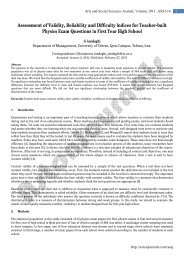
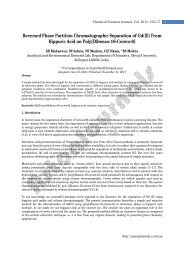
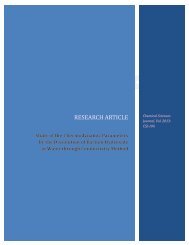
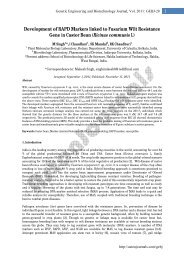

![[1,4]-benzodiazepine-2-one Derivatives as Potent - AstonJournals](https://img.yumpu.com/49117784/1/184x260/14-benzodiazepine-2-one-derivatives-as-potent-astonjournals.jpg?quality=85)
